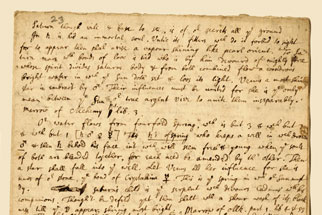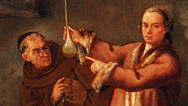Newton's Alchemy
- By Bill Newman
- Posted 11.15.05
- NOVA
Historian of science Bill Newman says that Isaac Newton's alchemical notebooks are like a gigantic jigsaw puzzle. But this puzzle is no child's play—more like an enigma wrapped in a mystery riddled with a number of misleading clues. With Newman's help, NOVA has "decoded" a page from one of Newton's 300-year-old manuscripts.
 Launch Interactive
Launch Interactive
He kept it hidden, but was Isaac Newton's alchemical work truly scandalous? See for yourself.
To orient yourself to the bewildering world of 17th-century alchemy, we recommend you first read our interview with Bill Newman before plunging into the interactive manuscript above. In addition, Newman has provided the following overview:
A Guide to the Alchemical Manuscript
This document, which Newton likely wrote in the mid-1670s, is part of an eight-page manuscript now housed at Yale University.* The manuscript contains extracts from Newton's favorite alchemist, the American writer George Starkey (1628-1665). Starkey's Marrow of Alchemy (1654-5), the work Newton cites here, was published under Starkey's pseudonym, Eirenaeus Philalethes ("a peaceful lover of truth").
Alchemical authors frequently employed a riddling style in the attempt both to reveal the text to clever readers and to hide it from those whom they considered unworthy. Starkey's text is no exception, but history has provided us with the means to decipher his allegories into a clear laboratory practice. Amazingly, the "plaintext" behind Starkey's extravagant game of alchemical metaphor has survived. A letter written in 1651 by the young American to the soon-to-be-famous scientific author Robert Boyle (1627-1691) contains a "Key into Antimony" that reveals the exact nature of Starkey's secret.
Starkey's laboratory practice, which Newton wanted to understand and reproduce, consisted first of reducing metallic antimony from its ore, stibnite, by heating the ore at high temperature with bits of iron. Further refinements would create crystalline "rays" on the surface of the metallic antimony, hence it was called the star-regulus of antimony. Starkey then fused the star-regulus with silver or copper, which allowed him to amalgamate the antimony with quicksilver. Eventually, he produced a "sophic mercury" in which gold could be made to dissolve and "vegetate"—forming tree-like growths. Starkey, and Newton, believed this "vegetation" was evidence that sophic mercury was a key to producing the ultimate agent of transmutation—the philosophers' stone.
Newton was fascinated by Starkey's encoded laboratory processes, extracting and interpreting them many times throughout his manuscripts. Like Starkey, Newton believed that ancient Greek and Roman mythology contained hidden alchemical secrets. For example, the story (found in Ovid's Metamorphoses) that the gods Venus and Mars, locked in an illicit embrace, were trapped in a bronze net by Venus's husband Vulcan was interpreted as an allegory for making an alloy of copper and star-regulus that Starkey called "the Net." Alchemists traditionally used planetary names for the metals, naming lead Saturn, iron Mars, tin Jupiter, gold Sol, copper Venus, quicksilver Mercury, and silver Luna, so it is easy to see how a fable concerning Venus and Mars could be seen as a chemical recipe.
Finally, it is important to note that by the mid-1670s, the young Newton had not yet fully deciphered Starkey's recipes. At this stage in his alchemical career, Newton did not realize that Starkey had substituted another referent, stibnite, for the usual material associated with Saturn, namely lead. Newton's later laboratory notebooks show that he would soon solve this riddle—one of many puzzles Newton faced in his alchemical work.
*The catalogue information for the manuscript is Yale University, Beinecke Library, Mellon MS. 79.
Credits
Produced by Susan K. Lewis
Photo
- (manuscript)
- Courtesy Beinecke Rare Book and Manuscript Library, Yale University
Related Links
-

Newton's Dark Secrets
Centuries-old manuscripts reveal the hidden pursuits of a scientific genius
-

Newton the Alchemist
Was Isaac Newton's practice of alchemy deviant in his own time? Historian Bill Newman offers perspective.
-

Einstein on Newton
In 1927, 200 years after Newton's death, Albert Einstein wrote a glowing appreciation.
-

A Complicated Man
If there's one word to describe Isaac Newton it is "genius," as this interview with historian Jed Buchwald makes clear.
You need the Flash Player plug-in to view this content.

